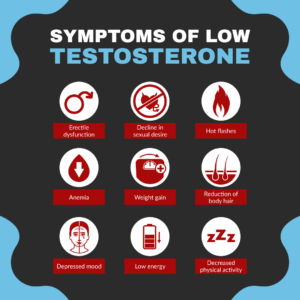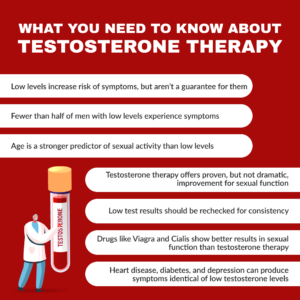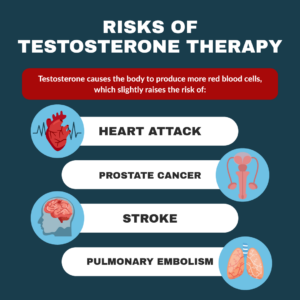For a relatively new treatment, testosterone therapy has already generated more than its share of controversy. While testosterone has been used for decades to treat certain medical disorders, it wasn’t until the early 2000s that doctors began prescribing it for symptoms of aging. This was in part due to relentless marketing by pharmaceutical companies, which rebranded normal declines in sex drive and athleticism as “low-T syndrome.” New prescriptions for testosterone increased by more than 400% in the decade following 2002.
Then, in 2014, the Food and Drug Administration (FDA) released a safety announcement publicizing the results of two studies that observed an increased risk of heart attack and stroke in those with prescriptions for testosterone therapy. The FDA emphasized that more evidence was needed before they could reach a definitive conclusion about the safety of these drugs. The use of testosterone dropped in the years since the announcement, as both doctors and patients became more cautious. There was also debate in the medical community about whether testosterone could accelerate the growth of tumors in patients with prostate cancer.
Testosterone Over a Lifespan

Contrary to what some might fear, testosterone levels never plummet in the way that female hormones do at menopause. Testosterone levels peak in the late teens and level off gradually, decreasing by up to 1% to 2% per year. Health and overall fitness may influence the extent to which this occurs.
As the New York Times writer Natasha Singer put it, “The science here is complicated by the fact that weight gain and illness can be accompanied by decreased testosterone levels.” In other words, low testosterone in older men is more likely the result of issues like weight gain and metabolic disorders than the cause. Given that context, it’s misleading to frame low testosterone as an isolated “syndrome” that afflicts people out of the blue. “Solvay Pharmaceuticals, which was then marketing [the testosterone gel] AndroGel, began using the term ‘low-T,” explains Singer, “replacing a previous euphemism for male aging, ‘andropause.’ ”
Medical Disorders Versus Aging
Some people do have medical disorders causing severe testosterone deficiency, but these are rare. These “hypogonadal” disorders occur when part of the “circuit” that produces testosterone isn’t functioning (either in the brain, or in the testes). Generally, these disorders crop up earlier in life, rather than occurring gradually as people age.
In contrast, age-related decline is more subtle and harder to distinguish from other health problems. Pharma companies capitalized on the confusion, glossing over the fact that the evidence for the positive effects of testosterone came from (mostly) younger people with issues like testicular injuries and congenital disorders. Researchers have since had to play catch-up to see whether testosterone actually benefits older men, who were already taking these prescriptions by the millions. This widespread prescribing occurred despite a lack of FDA approval for the use of testosterone for aging.
While drug companies referred to their “low-T” ad campaigns as “disease awareness initiatives,” critics in the medical community call the practice “disease mongering.” Instead of portraying aging as a difficult but inevitable part of the lifespan, the “low-T” rhetoric frames it as a disease with a cure.
The research that has accumulated since the FDA announcement suggests that the benefits of testosterone have been exaggerated. However, it may have modest benefits for a small percentage of men. The men who are good candidates for the medication are those with specific sexual health complaints and low testosterone readings across multiple tests. This applies equally to those with male physiology who identify as gender minorities.
Symptoms of Low Testosterone

Sexual symptoms are the most reliable indicators of low testosterone, especially when multiple sexual symptoms are present at once. These include issues like erectile dysfunction (ED), a decrease in sexual thoughts and a decline in sexual desire.
Physical signs can include hot flushes, anemia, weight gain and a reduction in body hair.
Nonspecific symptoms, like depressed mood, low energy and decreased physical activity, are less likely to be related to testosterone, especially if a person does not have sexual dysfunction at the same time. However, it may be worth getting hormones tested anyway to better understand what’s going on in the body.
Andrew McCullough, MD, professor of urology at Tufts University, describes a 66-year-old male with typical symptoms: “I was fine 10 years ago,” the patient reports. He is married and has always been attracted to his wife, but is unable to get or maintain an erection on some occasions. He also reports that lately he doesn’t get “turned on” and “can take it or leave it,” as far as sex is concerned. He describes feeling tired and mildly depressed.
While in this case, the patient’s testosterone level was well below the normal range, in other cases, depression alone can cause apathy and sexual dysfunction. That’s why it’s important to consult with both a physician and a mental health provider.
Testing Testosterone Levels
Testosterone can be measured with a blood test, which should be taken in the morning. Levels fall throughout the day, and the normal ranges are based on morning levels.
The results of the test are expressed in nmol/L (nanomoles per liter), or ng/dL (nanograms per deciliter).
If the test comes back low or borderline, a doctor may repeat it to make sure the results are consistent. Testosterone levels can vary substantially day-to-day, and “up to 30% of men with an initial abnormal [result] have a normal value on repeat testing.”
What Counts as a Normal Test Result?
Most men have testosterone levels in the range of 9 to 25 nmol/L, while a few have levels up to 40 or below 9 nmol/L. There is some variation in the average based on age and ethnicity.
According to one study, the likelihood of sexual dysfunction increases below a threshold of 8.5 nmol/L. However, a few people who are “borderline,” between about 8 and 11 nmol/L, may have symptoms as well. In these situations, a doctor may order more tests to see if there’s a low level of “free testosterone,” which is the portion of testosterone that is the most biologically active.
Does Low Testosterone Always Cause Problems?
A low testosterone level is a risk factor for symptoms, but it’s not a guarantee. In studies of older men with low testosterone, less than half of them are symptomatic. There are multiple reasons for this, but one is that some individuals have a low level of total testosterone and a normal level of free testosterone.
Testosterone is far from the only contributor to age-related symptoms and may not even be the most important one. Cardiovascular disease, diabetes and depression are all likely culprits as well.
ED is an example of a phenomenon that was blamed on low testosterone, until a more common underlying cause was discovered. “In the early part of the 20th century, [male hormone] deficiency was believed to be the predominant form of [ED],” writes McCullough. “As we began to understand [that ED has a basis in blood vessel dysfunction], the primary use of [hormone] replacement in the treatment of erectile dysfunction was abandoned.” Drugs like Viagra (sildenafil), that act by opening blood vessels, are now the first-line treatment for ED. McCullough notes that while testosterone is a factor in sexual health, studies in older men show that a person’s age is a better predictor of their sexual activity than their testosterone level.
Does Testosterone Replacement Therapy Work?

Clinical trials suggest that testosterone is effective for sexual symptoms and not much else. “You will hear a lot about testosterone improving fat mass, lean mass, muscle strength, cognition [and] physical function,“ says Shehzad Basaria, MD, in a 2016 lecture. Basaria is an endocrinologist and associate professor at Harvard Medical School. “Indeed, these benefits have been seen, mainly in younger men who truly have [brain disease] or testicular disease, because their levels are profoundly low. These benefits have not been seen in older men who have age-related decline.”
In 2016, the New England Journal of Medicine published the results of a yearlong randomized controlled trial of more than 700 symptomatic men. This is the largest randomized controlled trial of testosterone therapy to date, with a follow-up expected to be published before 2030. The average age of participants was 72 at the start of the trial, and the average testosterone level was clearly in the deficient range.
The treatment did show a clear, moderate benefit in improving sexual function compared to a placebo. The effects weren’t dramatic, but they suggest testosterone may be a useful treatment for patients like these. There is a caveat, however: for ED specifically, drugs like Viagra and Cialis (tadalafil) have shown better results than testosterone.
The benefits of testosterone for physical function and mood were negligible, and there were no effects on cognitive function.
Based on these results and others, the American College of Physicians recommends testosterone only as a treatment for sexual concerns, not for other symptoms, such as depression, fatigue or cognitive decline.
What Are the Risks of Testosterone Therapy?

Three of the major concerns related to testosterone are heart attack, prostate cancer and blood clots.
Testosterone causes the body to produce red blood cells, which, on the positive side, increases aerobic capacity. However, red blood cells thicken the blood, raising the risk of clots, heart attacks, pulmonary embolism and strokes. “Some of the [findings] that have come out with testosterone replacement and cardiovascular disease…might be because of elevation in [red blood cells],” says Basaria.
The current research on cardiovascular risk has major limitations. Since only a few people out of a thousand will have a cardiac emergency in a given year, a clinical trial would have to include thousands of people and go on for several years to get a robust estimate. We don’t have these large-scale trials yet, though one is currently underway.
The evidence we do have suggests a small overall increase in the risk of cardiac events, with an incidence rate of 2.7% in those on testosterone versus 2.2% in control groups.
However, these averages obscure the fact that individual characteristics play a role. For example, testosterone therapy is not associated with cardiac risk in younger people, but appear riskier in men in their 70s. A clinical trial of men with mobility impairments was terminated when there were nearly five times as many cardiovascular incidents in the testosterone group as in the control group. The study was later criticized for using drug dosages that were too high for that age group. “With aging, there is a decrease in the metabolic clearance rate of testosterone,” says Basaria, “so testosterone hangs around [in the body] for a longer period of time.”
It’s critical for patients to get regular blood tests while taking testosterone therapy to ensure that levels do not climb above the normal range.
The story with prostate cancer is incomplete as well. Small-scale trials have found that testosterone does not increase the risk of developing prostate cancer in those who have never had it. However, the real danger lies in a scenario in which a patient has existing prostate cancer, since supplementary hormones can fuel tumor growth. Getting screened before treatment can mitigate the risk, but it’s possible to have early cancer that does not show up on screenings. “I would argue that this issue is by no means closed,” adds Basaria.
Key Takeaways for Testosterone Therapy:
- L0w Testosterone can occur in older men, but it’s relatively uncommon compared to other age-related illnesses. Common illnesses like cardiovascular disease are often the root cause of the symptoms that men believe to be the result of low testosterone.
- Testosterone treatment is not effective for addressing general symptoms like fatigue or depression. Testosterone is best targeted to sexual symptoms only.
- The people who can benefit the most from hormone replacement are those with the lowest testosterone blood levels and the most severe symptoms.
- The risks of taking testosterone appear more manageable in young and middle-aged individuals. Whether testosterone is safe to use into older age, when cancer and other health threats are at their highest, is a more uncertain prospect.






